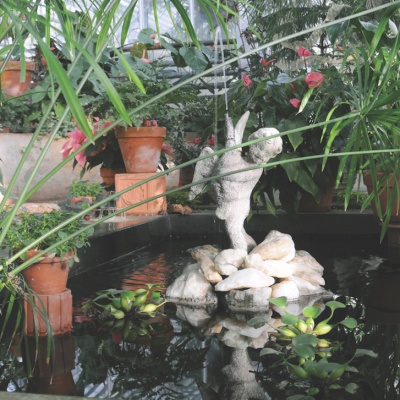A Slice of Eden

“By now I hope you are busily engaged in gardening. What a balm it is to worries and tension. Whenever I am upset I head straight out to my garden and after a few hours of pruning, digging, weeding, or picking off dead blossoms I feel that the world is alright again. Today is a gorgeous day and after my usual morning visit to the hospital, I plan to work outside this afternoon. Things are beginning to blossom out and I can’t bear to stay inside and miss any of the beauty.”
Alice Callaway in a letter to her friend, Katie Lynn, dated March 18, 1968.
What is it about gardening, or simply being in a lovely garden, that the human soul finds so soothing? To be sure, there are any number of opinions, but since I have your attention, here is mine: gardens touch something primordial in our psyche; instincts and responses arise from prehistory, perhaps from a time when we were much more attuned with the natural world than many of us are now. Those feelings of tranquility may happen because we’ve connected with our origins, an idea not so strange if you believe, as I do, that life itself began in just such a setting.
It is also my belief that all humans have some form of creativity given to them innately, and though the creative urge to garden might not be universal, it is very prevalent. It is an art form as well. That is another reason we are emotionally soothed by both the act of gardening and the experience of being in one, for the relationship between art and emotion is widely acknowledged. The above quote from Mrs. Callaway’s letter serves to underscore the research confirming that such productive activity is effective for relieving stress and anxiety, at the same time that it testifies to the joy of being surrounded by the garden’s spring charms.
We know that gardening for ornament and pleasure, rather than just for sustenance, dates back thousands of years. From the Hanging Gardens of ancient Babylon and the palace and temple gardens of Egypt, China and India, to Rome’s peristyle and villa gardens, it is clear that as civilization developed, humankind incorporated beautiful spaces for relaxation and entertaining. Happily, this art form once reserved for only the wealthiest institutions or members of society is now much more attainable for “average folk.”
So, suppose you want to create your own piece of paradise. What would be the required features to make it an actual garden? In other words, what would be needed to differentiate it from a pretty landscape or yard, if you will.
Consider these elements:
1) A path or paths. There must be one or more, depending on the size of the property. Also, ponder where each is going and where it will end. Paths can be grass, stone, gravel, brick, etc. Whatever suits you and your budget.
2) Enclosure. This gives a sense of privacy and being set apart from the rest of the world. Hedges, fences or walls come to mind here, with hedges being the least expensive and walls likely being the most.
3) An entrance. Be it an arched arbor or a gate, an entryway both invites the viewer in and divides the space from everywhere else.
4) Seating. People will want a place to sit and linger when the weather is nice and the surroundings are lovely.
5) Water. Every garden should have a water feature, but it need not be elaborate. Something about the sound of water, though, is so peaceful and calming.
6) Ornament. Items like appropriate figurines or statuary, sundials, birdbaths, and gazing globes fall into this category. Besides being attractive to look at, they also lend weight and counterpoint.
All of these details contribute to the ‘bone structure’ of a garden, so to speak. To borrow a phrase I heard once from talented garden designer and native Georgian, Brooks Garcia, “Beauty is all about good bone structure. If the garden looks good in January, it can’t help but look good in June.”
Other key aspects to a garden’s level of artistry and interest are pattern (achieved with plants or hardscape, for example), light and how it is captured or reflected, mystery, romance, and whimsy. Most of these can also be attained when incorporating the elements numbered above—that is, water can reflect light, as could an ornament; curved paths can lend an aura of mystery because the end might not be visible until a certain point is reached; ornaments can provide a sense of romance, whimsy, or perhaps both.
At this point, perhaps you’re inspired to begin working on your own slice of Eden. Don’t lose sight of the fact that creativity is simply the by-product of passion, hard work and tenacity. Or, perhaps you’re more inspired to visit an established garden, study and reflect on all of these design components, and soak in the beauty and peace. I know just the place… ~JP

South elevation view of the home from the face fountain in the Sunken Garden looking up at the terraces toward the home. |

Three Magnolia espaliers create the perfect backdrop for a seating area in the courtyard garden while indian hawthorne hedges encircle the quaint nook. |

Alice Callaway with the sundial in the Herb Garden circa 1970. |


